Shocking Paintings of Martyred Saints
The monthly ArtSmart Roundtable brings together some of the best art-focused travel blogs to post on a common theme. This month we are discussing Death & Darkness! Take a look at all the creative interpretations of his topic at the bottom of the page.

While images of St. Sebastian were often an excuse to paint the human figure, not all martyred Saints were this “elegant”. Peter Paul Rubens – “St Sebastian”, 1614, Staatliche Museen, Berlin (Photo)
November 1 was All Saints Day which got me thinking about this pantheon of holy men and women. The Saints can be grouped based on their spiritual achievements, like the Scholars, Leaders, Mystics and the Martyrs. For frightening, chilling stories, Halloween’s monsters have nothing on this last group! While they are revered as holy people, the lives of these Saints contain some gruesome tales of torture and execution. Since images have historically been used to educate viewers, may of the most disturbing images in art history depict the various grisly deaths of the martyr Saints.
As a religious ideal, martyred Saints were so devout and so committed that they were willing to subject themselves to painful deaths for their faith. To impress upon viewers the holiness of this suffering, effective images of the Saints had to be pretty graphic. Since the violence and pain were so linked to the Saint’s story, gruesome images appear across several artistic periods and throughout Europe.
St. Peter (the Martyr) of Verona
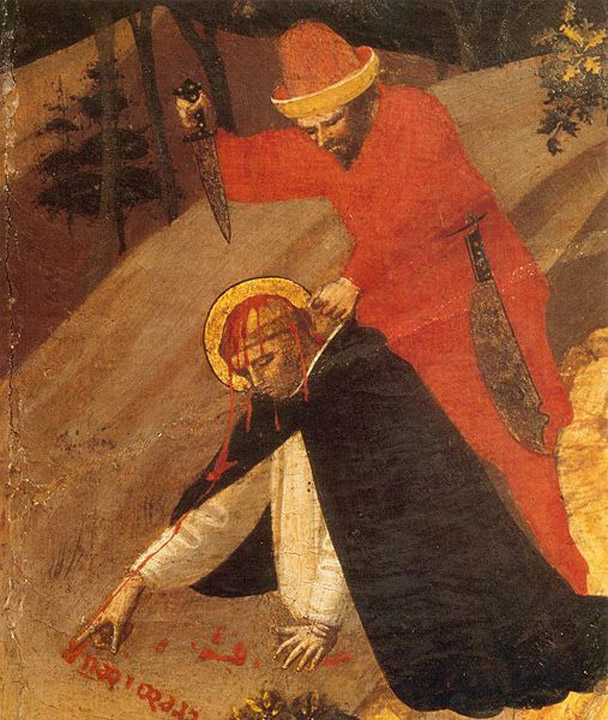
Fra Angelico – “St Peter Martyr Altarpiece (detail)”, Museo Nazionale di San Marco, Florence, Italy (Photo)
The world can be pretty violent sometimes as St. Peter the Martyr discovered. A Dominican friar born in 1206, Peter was an Inquisitor fighting heresy in Northern Italy. Some of his enemies hired an assassin who brutally killed Peter on an isolated road. He is believed to have written the Nicene Creed with his own blood on the road as he died.
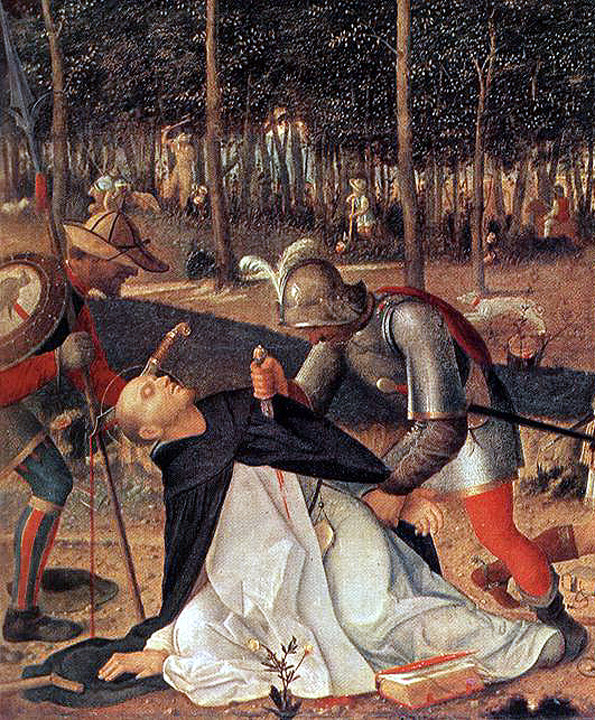
Giovanni Bellini – The Murder of St Peter the Martyr (detail)”, 1509, Courtauld Gallery, London (Photo)
In paintings, Peter is murdered with axes, swords, and knives which are often left in his body to illustrate the fatal injuries. To distinguish Peter from other Dominican saints, he is often shown with a knife right through his head.
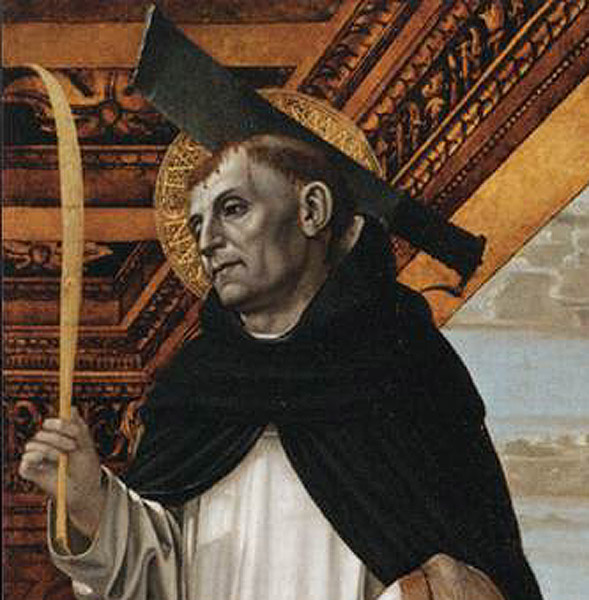
Ambrogio Bergognone – “Saint Pierre martyr and a female patron (detail)”, Musée du Louvre, Paris, (Photo)
St. Agatha of Silicy

Martyrdom of Saint Agatha in an Initial D: Cutting from an Antiphonary, ca. 1470–73, by Sano di Pietro (Sienese, 1405–1481). Metropolitan Museums of Art, New York (Photo)
As a teenager, Agatha (231 AD – 251 AD) took a vow of piety and purity. Refusing the advances of a Roman general, she was tortured by having her breasts cut off before finally dying in prison.
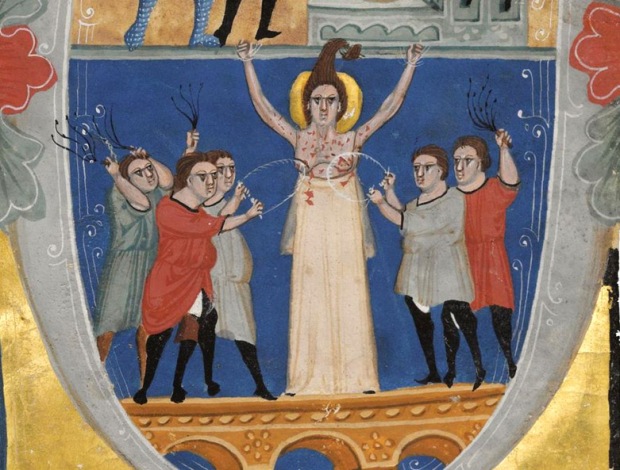
Breast removal with saws?! – The martyrdom of St. Agatha, in a letter “D” (detail), Sothebys Auctions, Dec 8, 2009 (Photo)
Maybe because I’m a woman, but I find images of Agatha’s martyrdom to be incredibly gruesome! Usually massive, garden shear-like pinchers or crude cutting tools are shown snipping off her breasts.

Sebastiano del Piombo, “Martyrdom of St Agatha”, 1520, Palazzo Pitti, Florence, Italy (Photo)
In more gentile paintings, Agatha holds her breasts on a plate as a symbol of her torture. It’s no wonder why St. Agatha is now the Patron saint of breast cancer patients.
St. Bartholomew the Apostle

Marco d’Agrate – “Statue of St. Bartholomew, with his own skin”, 1562, Milan Cathedral (Photo)
One of the original apostles, tradition holds that St. Bartholomew traveled to Turkey and Eastern Europe to preach. For refusing to worship local deities in modern day Armenia, he was sentenced to death by flaying following by beheading.

I was intended to find the source for this image, but searching for “flaying St. Bartholomew” became to scary of a task – “Martyrdom of St. Bartholomew” (Photo)
Images of St. Bartholomew’s martyrdom are violent, brutal, and typically show the skinning process just beginning or well underway especially in older images. It also became popular to show a normally dressed saint or completely skinless man holding his own skin like a cloak. Either way, paintings of St. Bartholomew are possibly the most disturbing of all the martyr Saints.
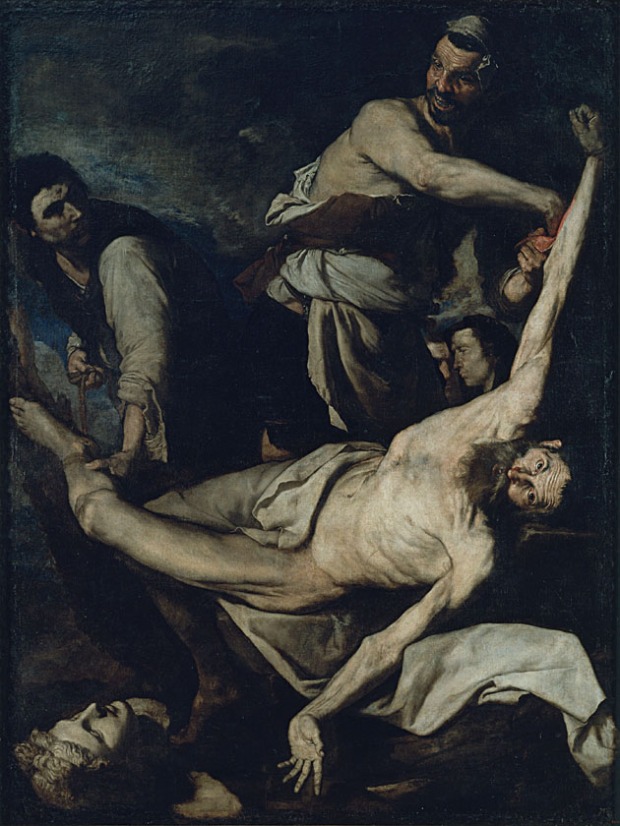
Josep de Ribera – “Martyrdom of Saint Bartholomew”, 1644, Museu Nacional d’Art de Catalunya, Barcelona (Photo)
So hopefully that wasn’t too scary! The mechanism of martyrdom was used to identify Saints and to teach viewers a valuable lesson about suffering and religious dedication. Unfortunately, the end result, in my opinion, were images so horrible that they could only have scared audiences into line. And in many cases, that visceral impact can still be felt today.
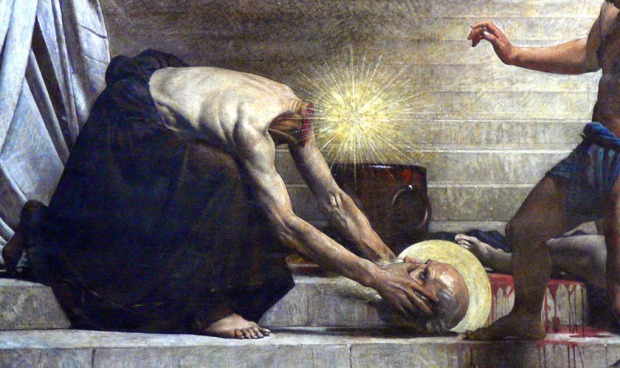
Following his decapitation in 258 C.E., St. Denis is said to have picked up his head, walked 6 miles, and given a sermon. “St. Denis Picking up His Head”, 19th century, Panthéon murals, Paris (Photo)
For the rest of the November ArtSmart Roundtable, check out:
- Jenna of This My Happiness –A Celebration of Death: Dia de los Muertos in Sacramento





So terrifying! I tend to avoid these images but I showed this post to some of my Grade 7 students and they thought it was excellent… I was reminded of a visit in 2002 to my mother-in-law’s childhood church on a trip to Italy. San Bartolomeo – the centre piece of the altar supported a statue of the Saint, stripped of skin and holding it in his arms. I couldn’t imagine sitting in that church as a child – even as an adult I never returned!
LikeLike
Yuck, pretty gruesome! I remember walking through the Louve viewing all the paintings full of martyrs and feeling sick 😝
The shorthand symbols for the martyrs (eyes for St Lucy, ax in the head for St Peter, etc) may have to do with the fact that much of the population was illiterate in the Middle Ages and these signifiers identified the Saint.
LikeLike
I am glad you covered this topic. It is amazing and terrifying to me that people were tortured and killed in such brutal ways. Have you watched the new FX tv show called “The Bastard Executioner” at all? The executioner must also torture and it is simply chilling to see all the crazy ways people came up with to inflict unimaginable pain!
LikeLike
That’s a terrific post!
LikeLike